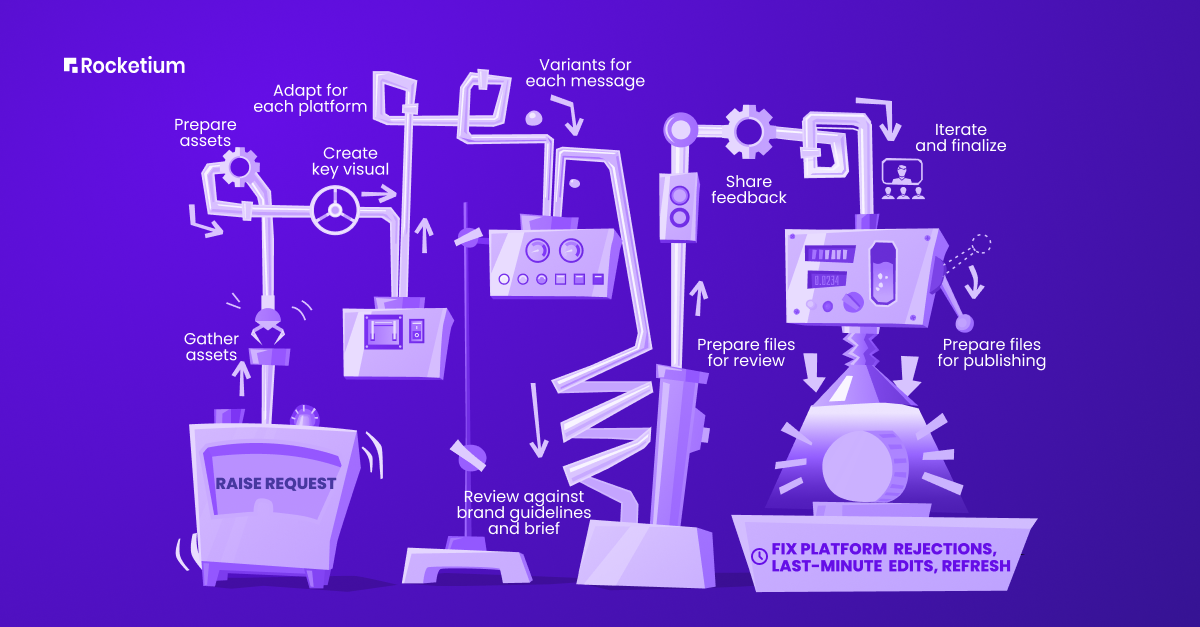

Ford’s assembly line was a turning point for the way automotive industries operated in the early 20th century, unlocking two important aspects of operational excellence – scale and efficiency. Productivity grew, wages grew and profits grew. This ops revolution echoed across many other sectors and transformed the way workforces around the world produced goods and services, helping many businesses survive several economic highs and lows.
Similarly, for today’s enterprise, the internet era of high-frequency communication demands for yet another ops revolution to take ideas to market faster, this time a creative operations revolution. Given that 93% of all communication is visual, the average brand today has about 8 seconds to grab people’s attention. To stay relevant, brands need to visually communicate much more, much faster.
The problem is — most enterprises continue to produce content for the digital world the way they would for traditional consumption on TV or offline billboards. This process is time-consuming, money-burning, and mired with manual, repetitive tasks. Enterprise communication seriously lacks the speed and efficiency needed to drive today’s marketing campaigns.
Like a Rube Goldberg machine, a brand’s communication infrastructure is often entangled in a loop of broken processes that stretch timelines and curb creativity; siloed teams that lack efficiency and collaborative deftness; and legacy tools that cannot scale production. And the challenge for today’s enterprise is to streamline these different parts into one robust communication engine.
Take for example one of the biggest bottlenecks in a marketing campaign lifecycle — brand safety and compliance. The process of ensuring brand safety has always been a nightmarish task of several folks — brand teams, legal teams and campaign managers — going through every asset and every creative to manually check if they comply with company guidelines, platform rules and other legal requirements. Even the world’s largest ecommerce platform rejects nearly 50% of creatives shared by brand advertisers for not being compliant with the guidelines of the platform, whether in terms of dimensions or branding. This rejection meant severely delayed campaign go-lives and significant revenue losses for the platform.
The journey of a campaign, from conception to go-live, is mired with such operational inefficiencies that result in heavy loss of business opportunities and spillage in campaign costs.

To really understand the pitfalls in the labyrinth of enterprise communication, let’s trace the arduous journey that a typical campaign manager takes to get a single campaign go-live.

Brands now need to achieve a level of efficiency that legacy tools and processes were just not built to support. For example, Adobe Photoshop was built to cater to professional designers’ requirements, one person at a time, along with years of training and high costs for licenses and upgrades. Because of that very reason, it has a fundamental limitation when it comes to collaborating, reviewing and helping non-designers access creative production. Moreover, scale was not built into its primary function, rendering it ineffective for bulk adaptations. The answer to this is not a different design tool like Figma because they too do not address the scale of communication needed for businesses to thrive in today’s digital ecosystem.
What we’re talking about is a CreativeOps revolution – taking a convoluted infrastructure that bleeds out time and money, and turning it into intelligent creative operations that make a brand’s communication infrastructure more agile, so that scale and speed are no longer challenges. A combination of “Creative” and “Operations”, CreativeOps brings together the various parts of design and marketing operations to help brands go live faster with their campaigns, translating to more business impact in much less time. This new agile CreativeOps is now being adopted by marketing teams across the globe, already benefiting industry giants like Amazon, McDonald’s, Walmart and Colgate-Palmolive.
But what really makes for good Creative Operations? Here’s a feature-level break down:

Now let’s look at how these aspects of great Creative operations are applied to real problems and transform businesses with faster launches, more market penetration, better conversions and campaign cost savings.
This food chain advertises everywhere to gain the largest share-of-voice in the fast-food market, and ends up spending upwards of $13M+ across digital and retail media networks. However, the brand was rapidly burning advertising dollars on decaying creatives since they could not refresh ads on time. They worked with agencies to produce campaign creatives but saw severe delays in launch times. However, the brand partnered with a CreativeOps platform and fixed several parts of its creative operations

Every brief was raised with a predefined template of campaign data, and every stakeholder was notified for each new brief and edits made on the design.

The brand adopted AI-powered creative automation to create adapts for all platforms, sizes and formats, bringing down the campaign cycle time by a whopping 50% and saving agency costs for adaptations by $300K+.

The brand teams also employed automated brand safety and platform compliance, further reducing campaign cycle time by 10%.

With much more efficient project management, the team refreshed creatives on time using self-serve editors, and drove 20% better return on ad spends.

Being the world’s largest online marketplace, sale seasons are an intense time for this platform. Every second counts when it comes to ensuring that prices, offers and discounts are updated to keep up with competitors. However, bandwidth issues and long campaign cycles lead to severe delays in updating sale offers and discounts for category sales. This resulted in loss of significant revenue opportunities because every second of lost time meant competitors were getting more sales. So the platform partnered with a CreativeOps provider to fix their problem.
The brand revamped its design systems with intelligent auto-tagging and brought down campaign cycle time by 50% with just this fix.
The brand also adopted creative automation and saved 30% of agency costs, and deployed automated brand safety checks which further shortened their campaign cycle by 80%. This improved their overall campaign management efficiency and they were able to refresh creatives on time, resulting in over 2.5x higher conversion during sales!

This retail giant struggled to penetrate into untapped geographic markets due to lack of bandwidth to personalize ads at language-level. This obstacle was lifted by adopting efficient CreativeOps: brand assets were first optimized in bulk with one-click background removals, extensions, etc., saving 15% of campaign cycle time.
Creative automation was adopted to clear up bandwidth for teams by 30%, giving them the time to create more personalized content at scale. This was followed by AI-powered brand safety automation which further brought down campaign cycle time by 15%.
Every enterprise already does CreativeOps in a way that it knows best.
But the magic of great CreativeOps is — it takes your existing teams, processes and tools and makes them much more efficient and intelligent, leading to more revenue and greater business outcomes.
If you’d like to understand more of how this can benefit your enterprise, reach out to us on marketing@rocketium.com. If you’re here at the Creative Production Los Angeles, come over to the Rocketium booth (No. 12) and we’ll be sure to take you through whatever you need!